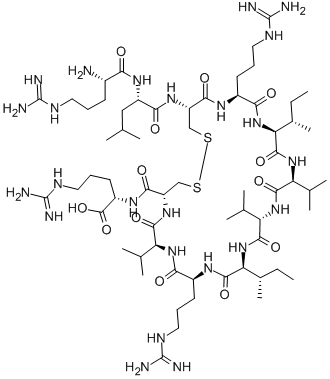牛抗菌肽

牛抗菌肽 性质
| 密度 | 1.43±0.1 g/cm3(Predicted) |
|---|---|
| 储存条件 | −20°C |
| 溶解度 | 溶于二甲基亚砜 |
| 酸度系数(pKa) | 3.50±0.21(Predicted) |
| 序列 | H-Arg-Leu-Cys-Arg-Ile-Val-Val-Ile-Arg-Val-Cys-Arg-OH(Disulfide bond) |
牛抗菌肽 用途与合成方法
牛抗菌肽是一种从牛嗜中性粒细胞中分离出来的有效的含12个氨基酸的环状抗菌肽。它可抑制细菌和酵母菌(bacteria 和 yeast)的生长,并能杀死真菌红毛癣菌(fungus Trichophyton rubrum)。它还可增加膜的通透性,抑制假苹果芽孢杆菌(B. pseudomallei)的生长和生物膜的形成。
根据分子结构特征,牛抗菌肽主要分为两大类:防御素(defensins)和cathelicidins。前者含有6个保守半胱氨酸,形成3个分子内二硫键;后者含有保守cathelin区域,形成结构各异的抗菌肽。牛抗菌肽共有13种,主要包括牛β一防御素、气管上皮抗菌肽、舌抗菌肽、肠上皮细胞抗菌肽(即肠肽素)及牛肽聚糖识别蛋白。 目前,关于牛抗菌肽的作用机理尚不明确。大多研究者认为,抗病原微生物的过程是由于其分子表面所带的正电荷可与表面带相反电荷的靶细胞发生反应,形成电压依赖的离子渗透性膜通道,破坏细胞膜的完整性,继而导致细胞死亡。Bacteria; Yeast; Fungus
Bactenecin is synthesized by solid-phase peptide synthesis and renatured to a fully disulfide bonded form. Bactenecin inhibits the growth of
Escherichia coli
and
Staphylococcus aureus
at the same concentration reported for the peptide purified from bovine neutrophils. Bactenecin inhibits the growth of other medically important bacteria and yeast, and it kills the fungus
Trichophyton rubrum
.
Bactenecin, a dodecapeptide, is strongly cytotoxic to rat embryonic neurons, fetal rat astrocytes and human glioblastoma cells.
Bactenecin exhibits stronger binding to LPS and induces perturbation of the inner membrane of live cells. Interaction of Bactenecin with model membranes results in changes in membrane fluidity and permeability, leading to leakage of dye across the membrane.
纯度(HPLC) ≥98.0%
醋酸根含量5.0%~12.0%
水分含量≤8.0%
肽含量≥80.0%

